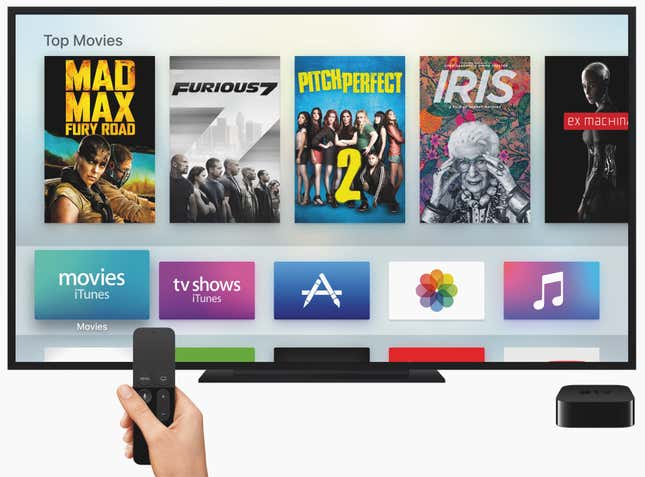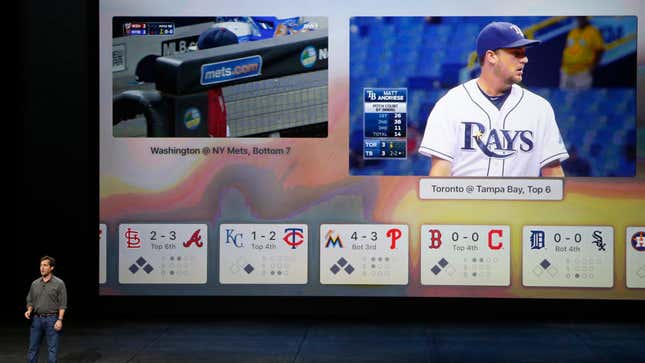Apple unveiled its new Apple TV streaming device in early September. The biggest change: It will now feature its own app store, including games.
In a media presentation, Apple CEO Tim Cook said apps were the future of television, and executives provided brief demos of new video search features and some potential apps. Apple has since sent test units to software developers to get started on creating apps. We haven’t heard much about the device since.
These are some of the things we’re eager to find out.
When—and where—will it go on sale?
Apple’s Sept. 9 press release says it will “be available at the end of October…from Apple.com, Apple’s retail stores and select Apple Authorized Resellers.” It doesn’t specify a date or the countries Apple will be selling it in.
More recently, 9 to 5 Mac reported that the Apple TV will “begin showing up in Apple Retail Stores for sale during the first week of November after going on sale via Apple’s website in late October,” citing “reliable sources.”
Barring any delays, it wouldn’t be a surprise for the first wave of media reviews—plus an official on-sale date—to appear this week or next. A Friday, Oct. 30, launch date seems plausible.
Which apps will come pre-installed?
For the past several years, Apple has controlled which content channels appear on its Apple TV boxes. You could hide them, but not add new ones. Now it will mostly be up to users, via the App Store.

But for the sake of simplicity and first impressions, will Apple pre-install some of the top video apps? And if so, which ones? One clue might come from the list of Apple’s initially supported partners for its new Siri voice-search feature, which are Netflix, Hulu, HBO, and Showtime. Might those apps be pre-installed? Or will Apple ask everyone to start fresh with just its iTunes store? (Will Apple also continue to feature its own channels, such as Apple Events or iTunes Festival, when newsworthy?)
Other streaming devices, such as Amazon’s Fire TV, typically come with top apps (at least Netflix and Hulu) pre-installed. Meanwhile, Apple is famous for only including its own apps on other new iOS devices. But Apple and Netflix seem to have some sort of broader partnership these days, so we wouldn’t be surprised to see it on the new Apple TV homescreen at launch or at least heavily featured in the App Store.
What about this bizarre Amazon fiasco?
Amazon, which aims to sell everything from patio furniture to toilet paper, is unexpectedly booting two rival streaming devices—Apple TV and Google’s Chromecast—from its store this month. “It’s important that the streaming media players we sell interact well with Prime Video in order to avoid customer confusion,” an Amazon rep told Quartz. “Roku, XBOX, PlayStation, and Fire TV are excellent choices.”
This raises several questions. Is Amazon making a Prime Video app for the new Apple TV? (It already has one for iPhones and iPads. A rep declined to comment.) Did Apple refuse to support Prime in its first set of voice-search partners? (Apple has pledged to open the feature to other companies in the future.) Does Amazon want its own voice search app to run on these devices? Is this just an experiment to see if relative exclusivity can drive market share for its new Fire TV devices?
Do many people even buy Apple TVs from Amazon? Will Amazon stop selling other devices—such as Vizio TVs—that offer sub-par Prime Video experiences? (Probably not!) Will Apple and Amazon reach some sort of middle ground?
This whole controversy is a bit of a stumper.
Where are Facebook and Twitter?
How will the top two social networks approach Apple TV? Facebook’s mobile app is the most popular of all time, and it is going hard after the video market. Twitter is in a more precarious state, but it controls several video properties, including Vine and Periscope, and video plays a central role in its new “Moments” feature. Also, what about sharing videos from Apple TV to Facebook or Twitter? Or opening videos from their feeds directly onto your big TV?
Our hunch is that neither company is rushing to build a big-screen version of its main app. But certain features feel like they might belong: a stream of just videos from your Facebook friends, perhaps? And it’s worth noting that Twitter’s Periscope app, for live streaming from your phone, recently added support for landscape videos that would fit better on a television set.
I asked Facebook COO Sheryl Sandberg about an Apple TV app at a recent press briefing in New York, and she seemed to suggest it’s not an immediate priority, especially relative to the main Facebook mobile app. “I think a lot of things that are displayed on one screen now will one day be displayed all over the place,” she said, “but we are not working on any specific new delivery.”
Is it the game console of the future?
Apple’s iPhone has become the world’s top mobile videogame platform, and the new Apple TV represents the company’s first real challenge to the living-room console incumbents. Does this spell trouble for Sony and Microsoft? Maybe.
“Maybe there will be people who do hardcore—what you think of as traditional, Halo-like or Call of Duty-like—games on an Apple TV. I don’t think so myself, but maybe that’ll happen,” says Robbie Bach, Microsoft’s former “chief Xbox officer” and author of the recent book Xbox Revisited. “I think what’s more likely is you’re going to have different things for different people, and market segmentation that happens.”
Apple certainly has a track record of popularizing new platforms, and it has made a point of highlighting games as a core feature of the Apple TV. And for a new player in the industry, Apple already has a head start, including thousands of existing games on iOS and Mac, social gaming capabilities via Game Center, and in-app purchases via iTunes.

But it seems Apple is more focused on getting companies to build new types of games for Apple TV rather than simply porting over existing iPhone and console games. For one, it is limiting the controls. While Apple TV will support third-party game controllers, such as those you’d use with an Xbox, it is requiring game developers to also support its standard remote control. The remote is an upgrade over its predecessor, including motion sensors and a touch panel. But it’s not an adequate replacement for a real game controller: It’s thin and not particularly ergonomic. The buttons are very simple, and it’s hard to imagine holding the remote lengthwise.
Perhaps Apple will change this policy in the future, but for now, it seems to favor simpler, more casual games over hardcore console titles—or at least developers that want to figure out a way to do both. The initial demos featured an Apple TV port of the popular iPhone game Crossy Road, which requires only basic controls, and a simple, new, Nintendo Wii-like game called Beat Sports.
For what it’s worth, Amazon does allow developers to require a game controller for Fire TV games, but it suggests supporting the remote, as well. Either way, Amazon has not yet made much of an impact on the gaming world.
What will apps even look like?
New app platforms are interesting because there aren’t any excellent, canonical examples to copy. Apple is offering its advice in the form of a Human Interface Guidelines website, where it describes the sort of user-interface elements it supports and recommends the right ways to use them. Tips include: “avoid unmotivated animation,” “defer to content over branding,” “favor muted colors,” and “keep primary content away from the edges of the screen.”

In canned and live demos, Gilt and Major League Baseball showed off apps that look different, but simple and elegant enough.
How will YouTube aggregators work?
One interesting use case for the Apple TV could be an aggregation app like Pluto.TV, which creates linear video “channels” like Xtreme Sports and Steve Jobs from other sources like YouTube. But Apple TV’s app kit doesn’t support basic web technologies, and YouTube uses a web-based “iframe” to embed its videos in iOS apps. We’ll have to see if YouTube will create a new tool for others to use its videos in Apple TV apps, or if it will use this as an excuse to keep its videos to itself. (We assume YouTube will create an Apple TV app.)
Why are there two different storage capacities?
One of the puzzling things is that Apple TV will ship in two different storage configurations, a 32 GB model for $149 and a 64 GB model for $199. Why the added complexity for something that is ostensibly an always-connected streaming device?

A simple explanation could be that people who plan to play a lot of games—which can store content locally—will want the extra space. We have an alternate conspiracy theory. Remember that streaming live-television service that Apple wanted to launch with this thing, but hasn’t been able to work out with the networks yet? Maybe it’s supposed to have a DVR feature? And that’s what all the extra space is for? We’ll see…
What else will it do?
Apple has touted video streaming, music, sports and weather, gaming, and shopping as early use cases. But this is basically an internet-connected computer that’s going to be hooked up to your TV. What else can we expect?

Controlling features of your home, via Apple’s HomeKit platform, seems like an obvious feature, and something Apple hasn’t talked much about yet. Will Apple eventually create some sort of camera accessory for living-room-couch FaceTiming? Is this where we’ll shop for vacations—or food delivery?
The other big question is what sort of an effect the new Apple TV will have on the TV, cable, internet, advertising, news, and sports industries. The iPhone, after all, was a bigger deal than anyone saw coming.
Will this have a profound effect on how people watch television content, sending them direct to the source? Will new ad-targeting capabilities make this a better way to advertise than on mass network TV? Will niche upstarts win against more-famous, slow-moving incumbents? Will sports leagues someday go direct? Is this Facebook’s ticket to social-video-distribution dominance—or a blockade?
Will half the cable channels exist in five years? Will broadband internet increasingly be sold by usage and consumption?
Are apps actually the next revolution in television? Or will this only have a modest effect?
